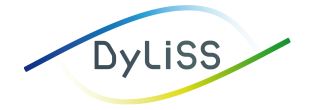Arnaud Belcour
Experience in Dyliss team
December 2022 – February 2023: Post-doctoral fellow (CNRS).
2019-2022: PhD Student (Inria) supervised by Anne Siegel and Samuel Blanquart.
Thesis subject: Combining knowledge-based and sequence comparison approaches to elucidate metabolic functions, from pathways to communities
2017-2019: Engineer (CNRS).
Dyliss team, Irisa / Inria Rennes-Bretagne Atlantique,
Campus de Beaulieu, 35042 Rennes Cedex, France.
Presentation
I worked in the Dyliss Team as an engineer and a PhD student by developing methods to study the metabolism of organism. This goes from the metabolism of microbiota to the metabolism of alga. These methods answer biologist question according to specific data (taxonomic affiliations form metabarcoding, genomes, Mass-to-Charge ratio). To answer these questions I have developed methods combining Knowledge engineering, Comparative Genomics and Systems Biology to infer and make prediction on the metabolism of microbial community, alga and taxonomic groups.
Links
ORCID: 0000-0003-1170-0785
GitHub: ArnaudBelcour
Publications
Thesis:
- Combining knowledge-based and sequence comparison approaches to elucidate metabolic functions, from pathways to communities.
Arnaud Belcour. Supervised by Samuel Blanquart and Anne Siegel. Jury: Delphine Ropers (Rapporteur), David Vallenet (Rapporteur), Cédric Lhoussaine (President), Olivier Dameron (Examiner), Karoline Faust (Examiner), Fabien Jourdan (Examiner).
Thesis at HAL (2022).
Major publications:
- Metage2Metabo, microbiota-scale metabolic complementarity for the identification of key species.
Arnaud Belcour, Clémence Frioux, Méziane Aite, Anthony Bretaudeau, Falk Hildebrand and Anne Siegel.
Article at eLife (2020), code.
- Inferring biochemical reactions and metabolite structures to cope with metabolic pathway drift.
Arnaud Belcour, Jean Girard, Méziane Aïte, Ludovic Delage, Camille Trottier, Charlotte Marteau, Cédric Leroux, Simon M Dittami, Pierre Sauleau, Erwan Corre, Jacques Nicolas, Catherine Boyen, Catherine Leblanc, Jonas Collén, Anne Siegel and Gabriel Markov.
Article at iScience (2020), bibtex, code.
Major preprints:
- EsMeCaTa: Estimating metabolic capabilities from taxonomic affiliations.
Arnaud Belcour, Baptiste Ruiz, Clémence Frioux, Samuel Blanquart and Anne Siegel.
Article at bioRxiv (2022). - AuCoMe: inferring and comparing metabolisms across heterogeneous sets of annotated genomess.
Arnaud Belcour, Jeanne Got, Méziane Aite, Ludovic Delage, Jonas Collen, Clémence Frioux, Catherine Leblanc, Simon M. Dittami, Samuel Blanquart, Gabriel V. Markov and Anne Siegel.
Article at bioRxiv (2022).
Softwares
Metage2Metabo: Identify key species in community by using metabolic complementarity from either genomes (in GenBank format) or metabolic networks (in SBML). Also other tools were developed with Metage2Metabo:
- emapper2gbk: Conversion of eggnog-mapper output files into a GenBank files (that can be used with Metage2Metabo).
- mpwt: Multiprocessing implementation of Pathway Tools to reconstruct draft metabolic networks in large-scale.
PathModel: Prototype using the Metabolic Pathway Drift assumption to infer alternative metabolic pathway from a reference metabolic pathway and known molecules (or mass-to-charge ratio) from metabolomics.
AuCoMe: Automatic comparison of metabolism for a group of organisms. By using heterogeneously annotated genomes from public databases, AuCoMe reconstructs homogenized metabolic networks by using sequence comparison.
EsMeCaTa: Estimating Metabolic Capabilities for Taxonomic Affiliations. From a taxonomic affiliations, EsMeCaTa searches for proteome on UniProt then clusters them with MMseqs to find the set of shared protein clusters among the protein and then extracts their annotations. By combining with Pathway Tools, it is then possible to have metabolic networks for a taxon.


